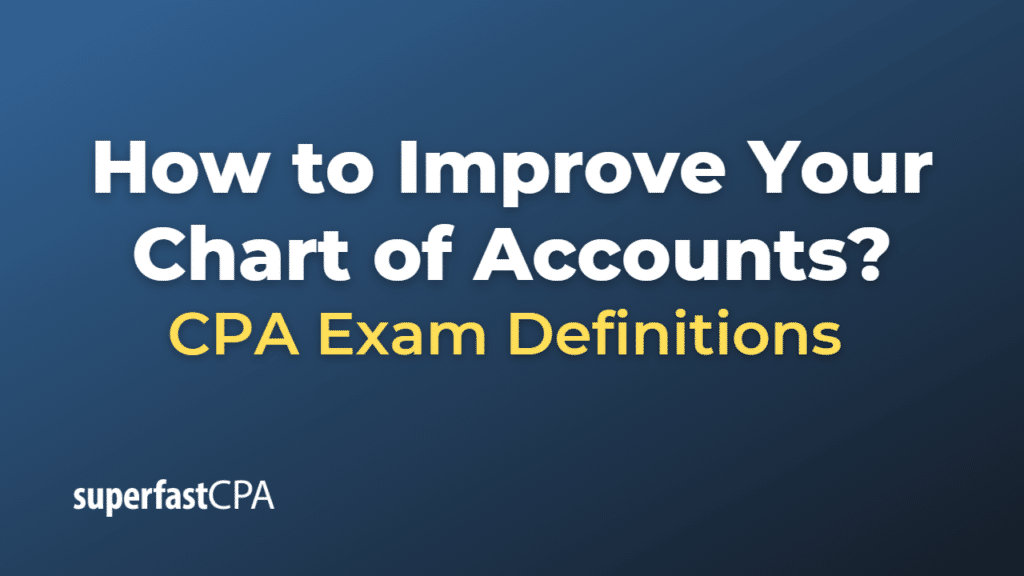How to Improve Your Chart of Accounts
The chart of accounts (COA) is a listing of all accounts used in the general ledger of an organization. It is structured in a way that reflects the operations of the company and provides a foundation for the reporting of financial information. Improving the chart of accounts can enhance your financial reporting and business decision-making. Here are a few ways to do that:
- Simplify and Streamline: An overly complex chart of accounts can make financial management more difficult. Eliminate unnecessary accounts, consolidate similar ones, and streamline your COA for easier understanding and use.
- Consistency is Key: Maintain consistency in the creation of new accounts. For example, if you have multiple revenue accounts, each representing a different product or service, the names should follow a consistent format.
- Use Appropriate Account Types: Each account should be designated as one of the five main types: assets, liabilities, equity, revenue, or expenses. Using the correct account type is essential for accurate financial reporting and analysis.
- Number Your Accounts: Numbering helps to organize accounts and makes it easier to locate specific ones. Generally, assets are in the 1000s, liabilities in the 2000s, equity in the 3000s, revenue in the 4000s, and expenses in the 5000s and above. However, the actual numbering system can vary based on the company’s needs.
- Hierarchical Structure: Implement a hierarchy, with “parent” accounts having “child” accounts. This structure allows for more detailed tracking and reporting. For example, an “Office Expenses” parent account could have child accounts like “Office Supplies,” “Utilities,” and “Rent.
- Periodic Review and Update: The chart of accounts should not be static; it should evolve as the business grows and changes. Regularly review and update your COA to ensure it remains relevant and useful.
- Alignment with Business Needs: Make sure your COA is structured in a way that aligns with your business reporting needs. For instance, if you need to track expenses by department, you should structure your expense accounts accordingly.
- Standardize Across Multiple Locations: If your business operates in multiple locations or departments, standardize the COA across all of them. This allows for consolidated reporting and makes it easier to compare performance across different parts of the business.
- Use Sub-Accounts: Sub-accounts allow you to break down your primary accounts further. This is useful if you need more detail than is provided by your main accounts. For example, you might break down “Advertising Expenses” into sub-accounts like “Online Advertising” and “Print Advertising.”
- Implement a System for New Account Creation: Establish a procedure for creating new accounts, including who has the authority to do so. This will help maintain the integrity and organization of your COA.
Remember that the goal of improving your COA is to enhance your financial management and decision-making capabilities. Make sure any changes you implement serve that goal.
Example of How to Improve Your Chart of Accounts
Let’s look at a fictional company, “EFG Hardware,” a medium-sized hardware retail chain with multiple locations. Here’s how EFG might improve their chart of accounts (COA):
- Simplify and Streamline: EFG finds they have several similar accounts, such as “Office Supplies – Branch A,” “Office Supplies – Branch B,” and so on. They decide to consolidate these into one “Office Supplies” account and use sub-accounts or classes to track the expenses for each branch.
- Consistency is Key: EFG ensures that all their accounts follow a consistent naming scheme. For example, all sales revenue accounts are named in the format “Sales – [Product Category].”
- Use Appropriate Account Types: EFG reviews all their accounts to make sure each one is assigned the correct account type. They correct a few errors, ensuring that their financial reporting will now be more accurate.
- Number Your Accounts: EFG implements a numbering system for their accounts, which makes it easier to find specific accounts and understand the type of account based on the number.
- Hierarchical Structure: EFG uses a hierarchical structure for their expense accounts. For example, they have a parent account for “Payroll Expenses” with child accounts for “Wages,” “Bonuses,” and “Employee Benefits.
- Periodic Review and Update: EFG sets up a semi-annual review of their COA to ensure that it still aligns with their current business needs and accounting practices.
- Alignment with Business Needs: EFG aligns their COA with their need to track sales by product category. They create separate revenue accounts for each main product category they sell.
- Standardize Across Multiple Locations: EFG standardizes the COA across all their retail locations, which allows for easier consolidated reporting and performance comparison.
- Use Sub-Accounts: EFG decides to further breakdown their “Advertising Expenses” account into sub-accounts such as “Radio Ads,” “Print Ads,” and “Online Ads” to better track and manage their advertising expenses.
- Implement a System for New Account Creation: EFG sets up a process whereby only the Chief Accountant has the authority to create new accounts in the COA, ensuring better control and consistency.
By implementing these strategies, EFG Hardware is able to improve its COA, making it a more effective tool for financial management and decision making.













